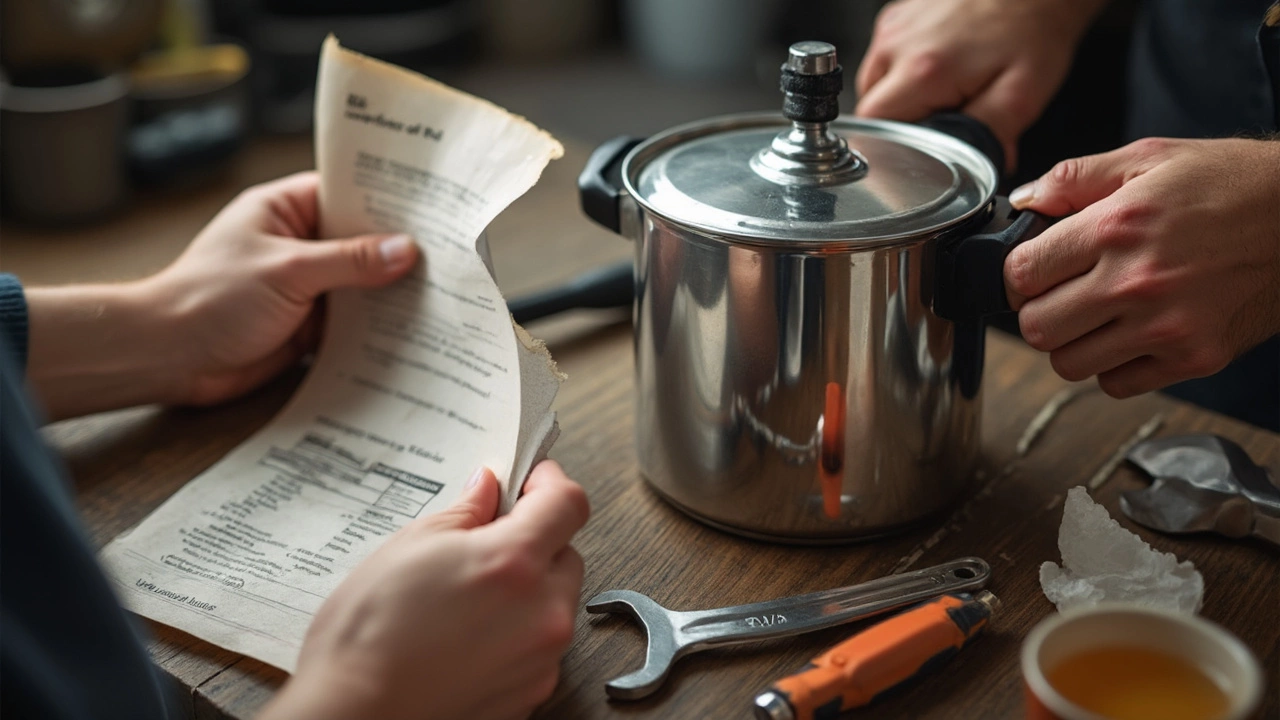Pressure cookers aren’t cheap, especially if you sprang for one with all the bells and whistles. So when yours suddenly stops working, it can feel like an emergency—like when my dog Max tries to bury his bone in the sofa cushions.
But before you start comparing new models or tossing your old one, it’s worth knowing that a lot of pressure cooker problems are actually fixable. Sometimes the lid won’t lock, steam leaks out, or you think it’s just plain dead. Most of these issues don’t mean your pressure cooker is done for. You might just have a worn-out gasket, a clogged valve, or a seal that’s out of place.
If you’re even a little bit handy and not afraid to get your hands a bit greasy, there’s a good chance you can sort out the problem yourself. And honestly, a bit of DIY repair can save you a lot of money—not to mention keeping all those tasty meals coming.
Let’s walk through the most common pressure cooker problems first, so you can figure out what’s actually wrong before you start poking around with a screwdriver or heading for the parts store.
- Common Pressure Cooker Problems
- DIY Repairs You Can Tackle
- When to Call a Pro (or Replace It)
- Tips to Prevent Breakdowns
Common Pressure Cooker Problems
If your pressure cooker isn’t working, chances are you’re dealing with an issue that plenty of folks have tackled before. Let’s look at the main things that go wrong with pressure cooker repair and what actually causes them.
- Steam Leaking Around the Lid: If steam is escaping from the lid area, this usually means the gasket (that rubbery ring) is worn out, dirty, or not sitting right. Sometimes, a little food stuck in the rim can make a whole lot of difference.
- Lid Won’t Close or Lock: People forget this, but a misaligned or damaged locking mechanism can leave you struggling. Always check for stuck food bits or bent pieces of metal.
- Pressure Isn’t Building Up: If your cooker doesn’t seem to be reaching pressure, that’s often a sign of a failed gasket, a clogged vent or valve, or not enough liquid inside. Instant Pots and electric models might also show an error code if something’s up.
- Valve or Vent Blockage: This is more common than you might think. Food debris or built-up residue can block the pressure release valve or float valve. Regular cleaning helps, but sometimes you need to take them apart.
- Burn Marks or Sticking Food: Burned food at the bottom can trip built-in sensors, especially in electric pressure cookers. This usually happens when the pot is too dry, or you’ve got heat set too high for too long.
- Broken Handles, Knobs, or Seals: After lots of use, plastic parts and seals can crack or snap off. Good news: most of these are replaceable parts you can find online.
To put it in perspective, a study by a major appliance repair chain found that over 60% of cooker troubleshooting service calls for home pressure cookers were for simple gasket or valve fixes. Only about 10% actually involved something more serious, like a busted heating element or an electronic board problem.
Most of these issues come down to wear, clogged vents, or seals and gaskets going bad—stuff you can spot and sometimes fix with a bit of patience and the right spare part.
DIY Repairs You Can Tackle
Surprisingly, a lot of the classic pressure cooker repair jobs are simple enough to handle in your own kitchen. You don’t need fancy tools—just some patience and a little know-how. Let’s hit the most common fixes so you can decide if your cooker is staying or heading out the door.
1. Replacing the Gasket (Rubber Ring)
If your cooker’s leaking steam around the rim or just won’t build pressure, the gasket is probably worn out. You can order a new one straight from the manufacturer or grab a compatible version online. To swap it out:
- Pop the lid off and remove the old gasket (it’s usually just sitting in a groove).
- Wash and dry the channel where it sits.
- Fit the new gasket evenly into place—no stretching.
This simple step fixes most leaks and restores even pressure cooking.
2. Cleaning or Replacing the Pressure Valve
Food bits clog the pressure valve more often than people realize. If steam's not coming out where it should, or your cooker won’t reach pressure, it’s time to clean it out:
- Remove the valve (check your manual for the exact method).
- Soak it in hot, soapy water and scrub with a soft brush—toothpicks work well for tiny holes.
- If it looks warped or damaged, buy a replacement.
3. Fixing a Loose Handle or Locking Mechanism
If the handle feels wobbly or the lid won’t lock shut, tighten the screws. For stripped screws or broken plastic, spare parts are easy to find for most major brands.
4. Checking for and Fixing Minor Electrical Issues (for Electric Pressure Cookers)
Sometimes an electric pressure cooker just won’t turn on. Double-check the power cord for any damage. It’s usually just a blown fuse or a faulty power cord, both of which are easily replaced with basic tools. If the display itself is dead, though, this is where most folks call it quits or seek professional help.
Cooks Illustrated says: “Regular replacement of gaskets and valve cleaning can add years to a pressure cooker’s life, often postponing the need for a new appliance.”
A quick reference can make even tricky repairs easier to follow. Here’s what usually goes wrong and what it takes to fix:
| Issue | Common DIY Fix | Difficulty |
|---|---|---|
| Leaking steam | Replace gasket, check for cracks | Easy |
| Not pressurizing | Clean/replace pressure valve | Easy |
| Loose handle | Tighten/replace screws | Easy |
| Power issues (Electric) | Replace cord/fuse | Moderate |
Don’t forget: stick with manufacturer instructions for any pressure cooker maintenance or parts replacement. Some brands are picky, and using the wrong part can void warranties, or just not work. Always unplug an electric cooker first before poking around inside.
A bit of elbow grease goes a long way toward keeping your cooker running. Most fixes cost very little, and you won’t need to mess with your dinner routine (or your wallet).

When to Call a Pro (or Replace It)
Sometimes, even the best DIY skills can't rescue your pressure cooker. If you’re facing an issue that involves the electronics, the heating element, or any deep internal problems, that's your cue to stop poking around yourself. For example, if the cooker just won’t turn on or keeps tripping the breaker, there’s a risk of making things worse. Brands like Instant Pot and Prestige make it clear in their manuals—tampering with electrical parts voids the warranty and can even get dangerous.
Also, there’s a line between what’s fixable at home and what just isn’t worth it. If your cooker has a dented pot, a warped lid, or the safety mechanisms don’t work, it’s time to retire it. Safety is non-negotiable—pressure cookers work by trapping hot steam, so weak seals or faulty valves mean trouble. According to the Consumer Product Safety Commission, faulty pressure cookers cause hundreds of injuries every year when not repaired correctly.
Here’s a quick rundown on when to skip the DIY and get pro help or buy a new cooker:
- The electrical board is burnt or smells weird.
- There’s visible damage to the lid locking system.
- Steam leaks from multiple places, even after changing the gasket and cleaning everything.
- Parts are no longer available for your model.
- You see cracks in the pot or severe rust inside.
"If replacing worn or faulty components doesn't resolve the issue, or if your pressure cooker’s damage involves the wiring or heating element, professional repair—or even full replacement—is usually the safest choice." — Good Housekeeping Institute
Replacement might feel like giving up, but old or discontinued models are almost impossible to fix if you can't get parts. Plus, the newer versions often have better safety and energy features, saving you time and worry in the long run.
| Repair Cost Estimate | Typical Professional Service Fee (USD) |
|---|---|
| Replace Gasket/Valves | $20-40 |
| Heating Element Repair | $50-100 |
| Lid/Safety Lock Repair | $30-60 |
| Full Electronic Board | $70-150 |
If your repair bill creeps close to the price of a brand-new pressure cooker, just let the old one go. Invest in a new cooker and keep those kitchen wins coming.
Tips to Prevent Breakdowns
If you want to avoid the headache of pressure cooker repair, a little bit of care goes a long way. Most cooker issues start with small things people just ignore. So, here’s what actually matters when it comes to keeping your appliance in good shape and ready for all your quick meals.
- Clean every part after each use. Don’t just wipe the pot and call it a day. Food can get stuck in the pressure valve, seal, or gasket. Always remove the gasket and wash it with warm, soapy water. Clean the valve with a small brush or toothpick if needed.
- Check the gasket regularly. The gasket is the rubber ring that seals the lid. Over time, it stretches, cracks, or hardens, and it’s the number one cause of leaks. Check for cracks or wear every couple of months. If it looks rough, swap it out—most brands sell replacements for cheap.
- Don’t force the lid. If the lid isn’t closing smoothly, don’t try to muscle it shut. Something’s probably not aligned or the gasket isn’t seated right. Forcing it can damage the locking mechanism, and that’s an expensive fix.
- Descale every few months. Hard water can build up inside, especially around valves and seals. Just add a cup of vinegar with water, run the cooker for 10 minutes, and rinse after. This keeps all moving parts working and prevents little blockages.
- Store it properly. Don’t clamp the lid down tight when you’re not using the cooker. Leave it loose, or store the lid upside down. This helps the gasket stay flexible and stops it from sticking to the rim.
- Replace worn-out parts. Things like safety plugs, handles, and valves don’t last forever. If you see any cracks, warping, or melted bits, order a new part. Using a dodgy safety plug isn’t worth the risk.
Here’s a quick look at how often you should check and maintain the main parts to dodge those annoying cooker repair headaches:
| Part | Maintenance Frequency | Typical Lifespan |
|---|---|---|
| Gasket | Every 1-2 months | 12-24 months |
| Valve | Every use/Monthly deep clean | 2-3 years |
| Lid seals & safety plugs | Check with each use | 1-2 years |
Sticking to these simple habits not only cuts down on how often you’ll need cooker troubleshooting, but also keeps your meals safe and your cooker running smoothly. Trust me, it beats suddenly having dinner plans ruined by a busted pressure cooker.





